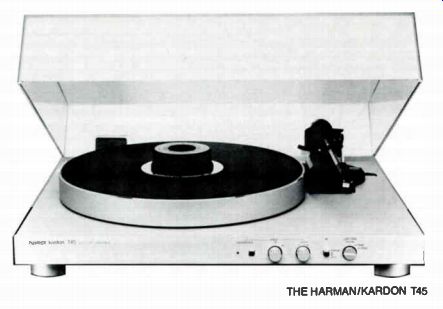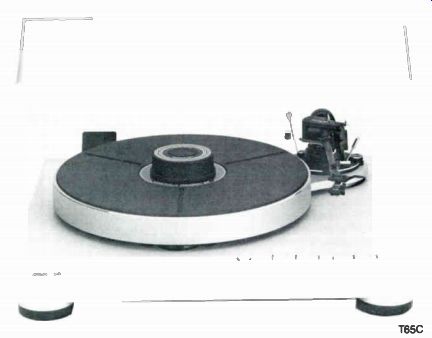| Home | Audio mag. | Stereo Review mag. | High Fidelity mag. | AE/AA mag.
|
by Stephen W. Watkinson
HARMAN/KARDON T45
Belt-drive analog turntable with tonearm.
Wow & flutter: 0.04%. Rumble: -68 dB. Price: $300.
HARMAN/KARDON T65C
Belt-drive analog turntable with tonearm.
Wow & flutter: 0.025%. Rumble: -70 dB. Price: $575.
MANUFACTURER: Harman/Kardon, 240 Crossways Park West, Woodbury, New York 11797.

Of all the great names from the Golden Age of Hi-Fi that that have resorted to Far Eastern manufacturing, such as Fisher. Scott, and Marantz, only Harman/Kardon still produces components worthy of consideration as true hi-fi equipment. In recent years the company's turntables have been well received by the audiophile community as offering excellent value-ideal for use in less expensive systems. The 165C is the successor to the very popular T60, and the T45 is H/K's replacement for the less well known (among audiophiles) and less costly, too. Both 'tables are slightly larger and considerably more massive than the typical Japanese turntable. As has become de rigeur with such products. each is silver with a jet black tonearm. Belt drive, servo motor, a very compliant platter mat, and a reasonably effective record weight are featured in both 'tables.
The principle differences between the T45 and T65C are the 65's suspended sub chassis and superior tonearm. The tonearm on the 65C, though similar in appearance to that on the 45 (as, in fact, is the whole 'table), on close inspection is quite different.
It has a heavier counterweight, weight controlled anti-skating, a smoother, more solid feel, and is capable of handling more massive cartridges. Although it is difficult to tell how much difference the tonearms make in the overall sonic qualities of the two tables. I suspect it to be substantial.
Quite frankly, the T45 just isn't up to audiophile standards. Detail is lackluster-only a little better than the typical Japanese budget turntable. Strings don't separate well, and much of the ambience on classical recordings is lost. High frequencies are there, but lacking in air and delicacy. The low bass is anemic, and different instruments are difficult to distinguish from one another in the midbass. (I found it hard to tell the difference between electric bass and kickdrum on pop recordings.) The buzz and echo on low synthesizer notes is murky.
At first I suspected that an incompatibility between the T45's tonearm and my moving coil cartridge might be responsible for the 'table's poor performance. Even though the MC cartridge in question was light and compliant by moving coil standards, it seemed to have just too much mass and energy for the tonearm. I then tried the T45 with two different moving magnets: the change didn't help. Even on a different surface and in different locations in the listening room the results from the 45 were simply unacceptable for use in an audiophile system.
The T65C's story is quite a bit different.
This is a damn good little turntable for the price. It does just about everything fairly well, with real weaknesses only in the extreme bass and extreme treble regions. The 65C has respectable resolution and a nice overall tonal balance, and, though there are some problems in the low bass, the midbass is tight: it was easy to pick out the different bass instruments. High frequencies were coherent and free of the lower treble aggression found in many less expensive 'tables.
The highs had good air and ambience through the mid-treble, but the top octave had some grain, and sounded a bit closed in.
The soundstage lacks the width and depth that the best 'tables and arms are capable of producing. Um especially notice this deficiency when using a cartridge and speakers that perform well in this area. Even with the Dayton Wright XAM-4s, whose sound stage is as large as any speaker I've heard, the 65 had trouble creating a horizontal image wider than the distance between the speakers. There was also a slight lack of stability to the image, and the upper harmonics of voices and some instruments would at times seem disembodied from their apparent source, very much like the upper harmonic disembodiment common with early CD players.
Although the overall tonal balance was good, some narrow bandwidth resonances were noticeable on critical listening. They were most prevalent in the lower midrange, but noticeable to a lesser extent through most of the frequency spectrum. I suspect the problem is attributable to the tonearm, and would be less serious with more compliant cartridges than mine (a Talisman S). These may sound like serious criticisms, hut they are problems I would expect from a 'table/arm combination in the 65C's price range.' They showed up in direct comparison to a state of the art turntable (a fully upgraded SOTA Star Sapphire with Sumiko Arm or WTA -almost a $3000 combination), on a reference quality system. You shouldn't think the T65C is anything but an excellent performer for its price. You will have to spend at least $1000 to get a turntable/tonearm combination that's largely free of the T65's problems.
The less expensive systems with which the T65C is likely to be used are more forgiving of turntable flaws, so, to provide a more meaningful review, I assembled a high quality budget audiophile system. My goal was to keep the cost of the system, exclusive of turntable, at about $2500. I used the highly regarded PS Audio IVH preamp, Eagle 2 amplifier, and excellent little Day ton Wright LC:M-1s. My cartridge was a Sumiko Alchemist III-S. This system offers a level of performance about as high as is available for the price, though it's of significantly lower resolution, and quite a hit weaker at the frequency extremes, than my reference system.
On the budget system the differences
------------ I I've shopped around for the T65C; as with most widely distributed audio products, I found many dealers offering significant discounts. A smart shopper should he able to pick up a T65C for around S-i5O in competitive markets.
--------------
between the 65C and my reference SOTA Star were far less noticeable. With the reduction in frequency extension, the 65C's tonearm resonance problems were not as apparent, and the soundstage differences between the two phono systems were less noticeable. The image instability with the 65C, however, actually seemed worse in the budget system. , Not surprisingly, the SOTA was still a clear winner, but the differences were far less noticeable, and certainly didn't justify the difference in price.' Upgrading the components in the budget system increased the observed differences between the 'tables such that, at the level of my reference system, the 65C was noticeably degrading the overall performance of the system. I suspect most audiophiles with this kind of system would replace it immediately.
------------------- 2 I believe this problem can be blamed on the pre-amp.
slight shimmer was also noticeable with the SOTA in the budget system. and came up when the PS IVH was inserted into my reference system.
3. My experiences with this test directly contradict the British philosophy of allocating an extremely large portion of a ',rein's price to the turntable. The sound quality of the budget system improved just as much, if not more, with the substitution of a better pair of speaker. as it did when I switched from the T655: to the SOTA I would question the wisdom of allocating the largest portion of your budget to the turntable: a balanced approach scents the best course
----------------------------
My conclusion? I heartily recommend the T65C for use in basic audiophile systems, with only the caveat that it will need to be replaced if you then upgrade your system significantly. This 'table offers very good performance for its customarily discounted selling price: I couldn't be as positive if you're paying full list. There are a number of excellent turntable/tonearm combinations available in the $550 price range. including the recently resurrected Sonographe.

-------------- T65C
One advantage the T65C offers over the competition in this price range is its ease of setup and use: for someone who wishes to spend as little time futzing as possible, the T65C is probably the best choice.
The same can not be said for the 45: my advice is to stay away. There are a number of preferable alternatives, including, at considerably less money, the latest version of the Dual 505.
--
[based on a March 1986, Stereophile review article]
Also see:
SOTA VACUUM SUPER MAT / ELECTRONIC FLYWHEEL
THE WIN MC CARTRIDGE AND PREAMP
THE CONRAD JOHNSON MV-50 AMPLIFIER
THE NEC CD-705E COMPACT DISC PLAYER
THE INFINITY IRS-III AND RS-IB: STILL FURTHER CONSIDERATIONS
THE RAUNA TYR MARK II LOUDSPEAKER
THE SYNTHESIS LM-20 AND LM-250: A NEW LINE OF TOP QUALITY SPEAKERS
Prev. | Next |